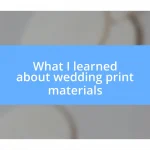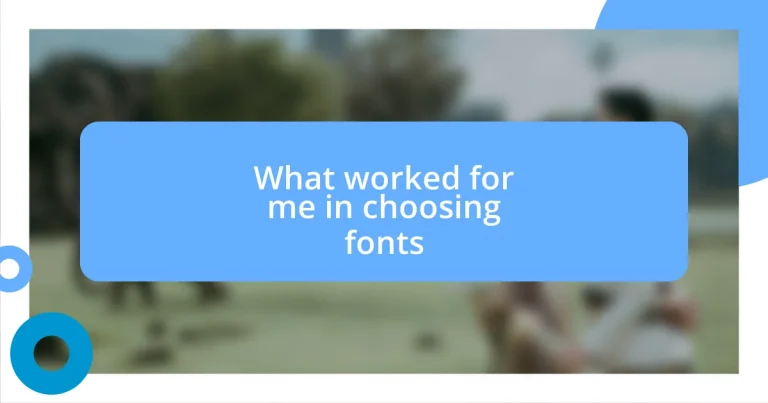Key takeaways:
- Font choice significantly influences brand perception, readability, and emotional connection; selecting the right font is crucial for effective communication.
- Evaluating font legibility involves considering factors like size, line height, contrast, character shape, and text length to ensure clarity and engagement.
- Testing fonts in real projects helps to understand audience reactions and the contextual impact of different fonts, emphasizing the importance of prioritizing user experience.
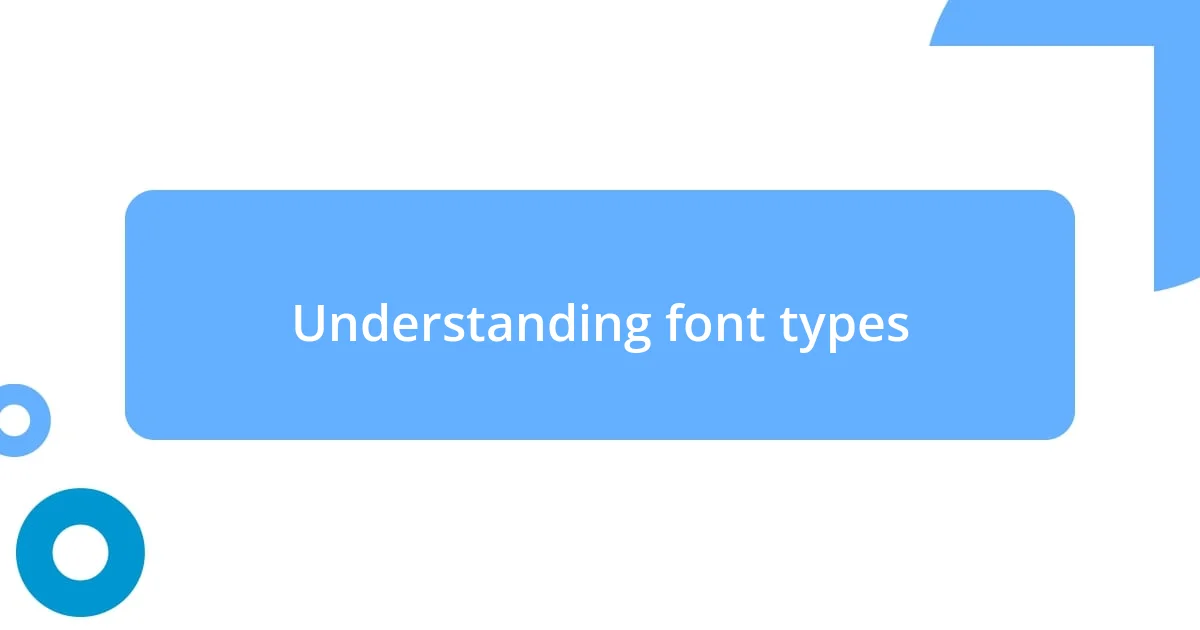
Understanding font types
When I first started exploring font types, I was amazed by how much personality a font could convey. For instance, a sleek sans-serif felt modern and friendly, while a traditional serif carried an air of professionalism and elegance. Have you ever noticed how a simple change in font can dramatically alter your perception of a brand or message?
One thing that struck me was the versatility of display fonts. They can transform the look of a project, drawing attention instantly. I once used a bold display font for a personal project, and the response was overwhelmingly positive—people felt energized just looking at it. I often wonder if that same energy translates into the choices I make for my professional work.
Don’t underestimate the impact of font types on readability, either. In my experience, using a clean font in longer texts can make a world of difference. I remember grappling with an overly ornate font that looked beautiful but proved frustrating for readers. Have you ever had that moment where you had to squint to make sense of the words? It’s a crucial reminder that functionality and aesthetics must go hand in hand.
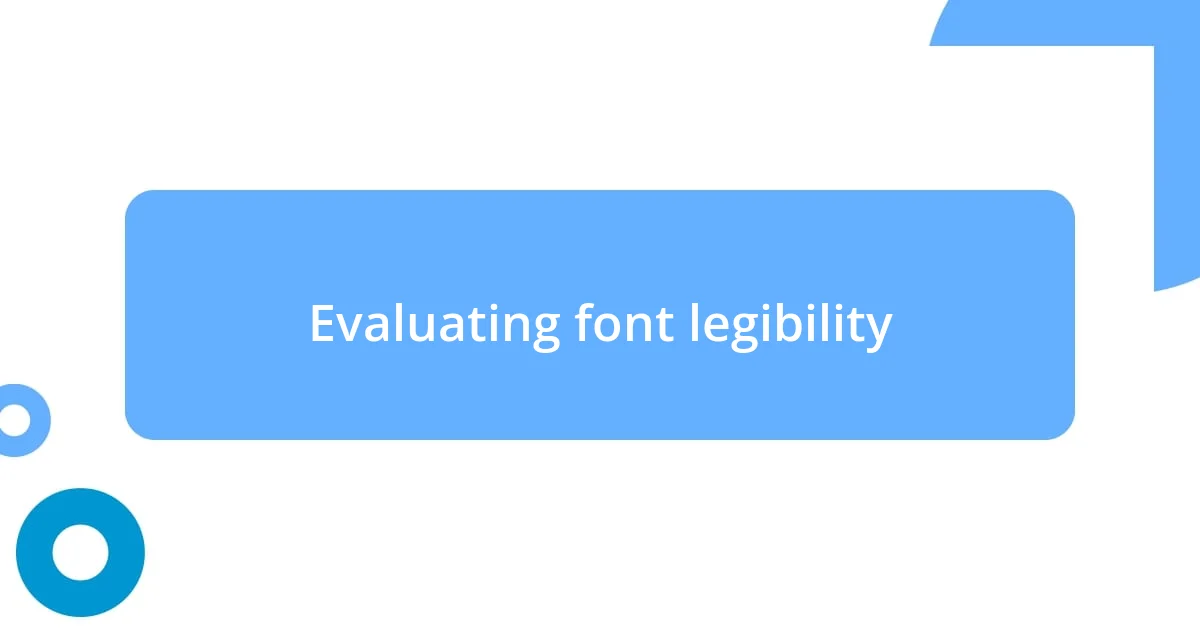
Evaluating font legibility
Evaluating font legibility is an essential step I always take in my design process. I vividly remember a time when I chose a beautiful script font for a project, certain it would add elegance. However, when I saw my audience squinting to read the content, I realized that beauty can’t replace clarity. A font may look stunning, but if it’s hard to read, it defeats its purpose.
Here are some key factors I consider when assessing font legibility:
- Font Size: Larger sizes generally enhance legibility, especially for body text.
- Line Height: Adequate spacing between lines helps prevent the text from feeling cramped.
- Contrast: A high contrast between the font color and background color improves readability significantly.
- Character Shape: Fonts with open characters, like ‘a’ and ‘g,’ tend to be easier to read, especially for those with visual impairments.
- Text Length: Shorter lines are usually easier to read than longer ones, guiding readers through the text seamlessly.
These factors help me strike the right balance between aesthetics and function, keeping my audience engaged without frustration.
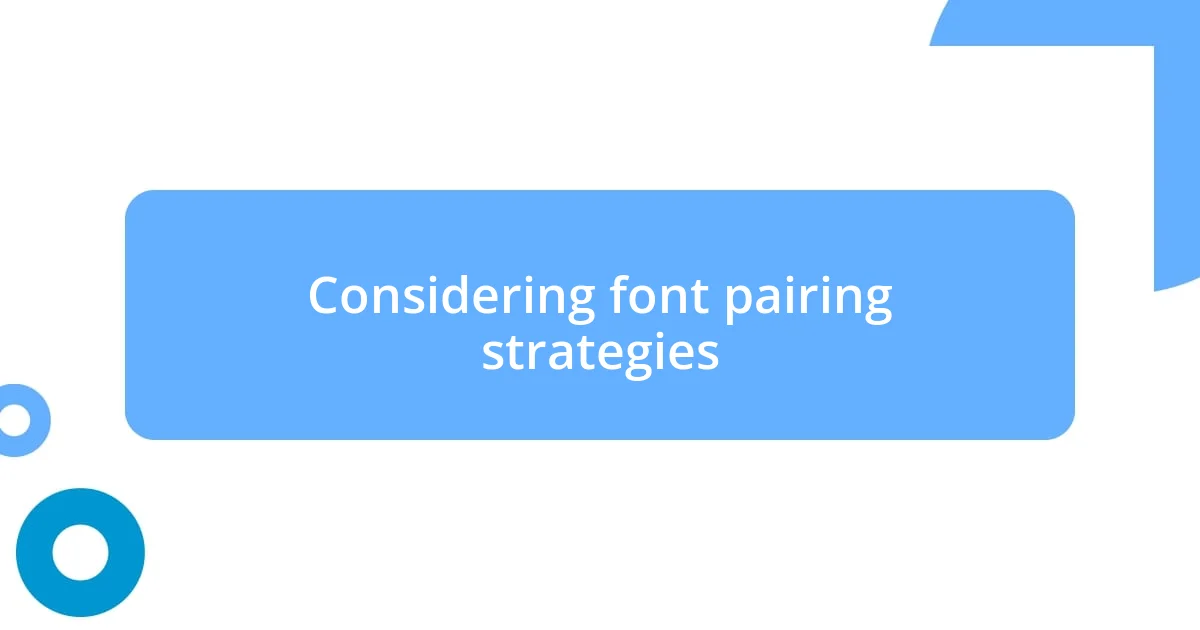
Considering font pairing strategies
When it comes to font pairing, I often find myself considering how different fonts can complement each other to create a rounded visual experience. For instance, I once paired a strong serif font with a clean sans-serif for an invitation I designed; the combination provided elegance and modernity. It’s fascinating how such pairings can evoke distinct feelings, don’t you think?
In my design adventures, I’ve learned that contrasting font styles can add depth to your work. While exploring various pairings, I discovered that pairing a bold, attention-grabbing font with a more subdued, minimalist option can really make the key elements pop. I remember when I applied this strategy on a blog post header, and the result was both striking and readable, drawing readers in without overwhelming them.
It’s also essential to maintain a harmonious relationship between the fonts you choose. I always pay attention to the weight and style of the fonts; a chaotic mix can distract rather than enhance. A few months ago, I experimented with a playful handwritten font alongside a structured typeface, and it taught me how intentionality in font choice can reflect the brand’s character beautifully—a lesson I’ll never forget.
| Font Pairing Strategy | Description |
|---|---|
| Contrasting Styles | Combining bold and minimalist fonts to create visual interest. |
| Complementary Choices | Using a serif with a sans-serif to highlight elegance and modernity. |
| Harmonious Relationships | Ensuring weight and style balance for a cohesive design. |
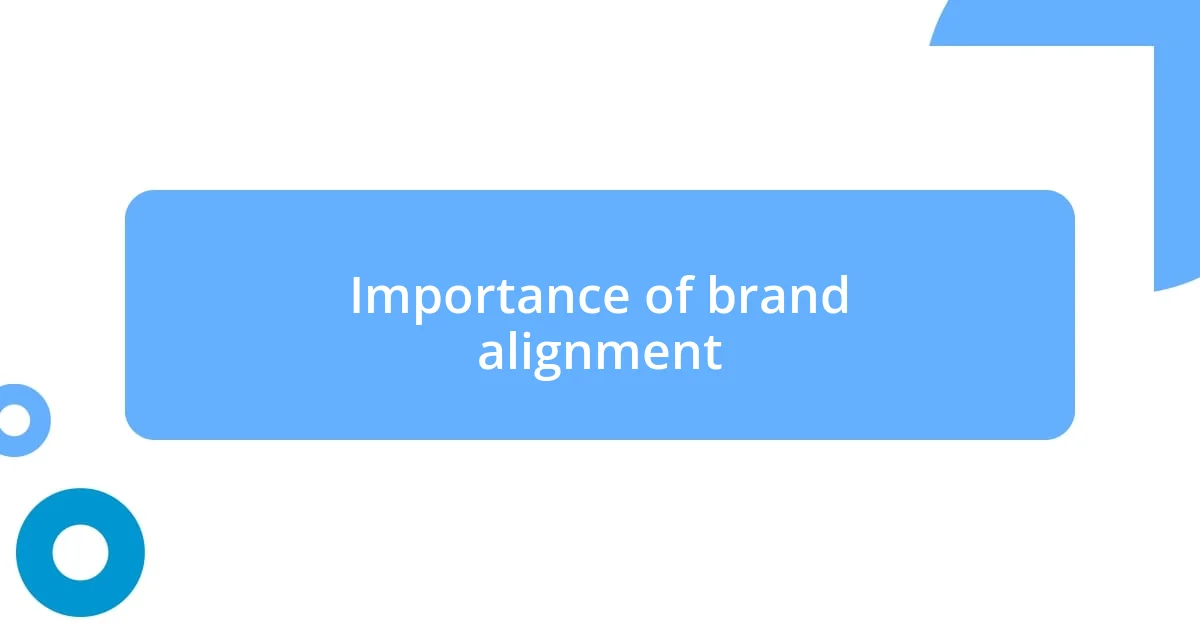
Importance of brand alignment
When it comes to brand alignment, I truly believe that the fonts you choose should embody the essence of your business. For example, when I crafted a logo for a tech startup, selecting a geometric sans-serif font felt instinctively right. It conveyed modernity and innovation, perfectly matching the company’s mission. Isn’t it interesting how a typeface can reflect a brand’s personality so profoundly?
There’s something powerful about consistent brand alignment through fonts; it fosters familiarity and trust. I once worked with a small bakery that had a charming, rustic vibe. By using a handcrafted-style font across their packaging and marketing materials, we elevated their brand coherence. I noticed that customers felt more connected; that sense of community was palpable when they saw the same style they loved everywhere.
Aligning fonts with your brand’s message doesn’t just appeal visually—it creates an emotional connection with your audience. I remember rebranding a client’s website with a clean, approachable font that echoed their friendly service. The feedback was overwhelming. Customers expressed how the easy-to-read type made them feel welcomed and valued. Isn’t it amazing how something as simple as font choice can enhance or hinder that connection with your audience?
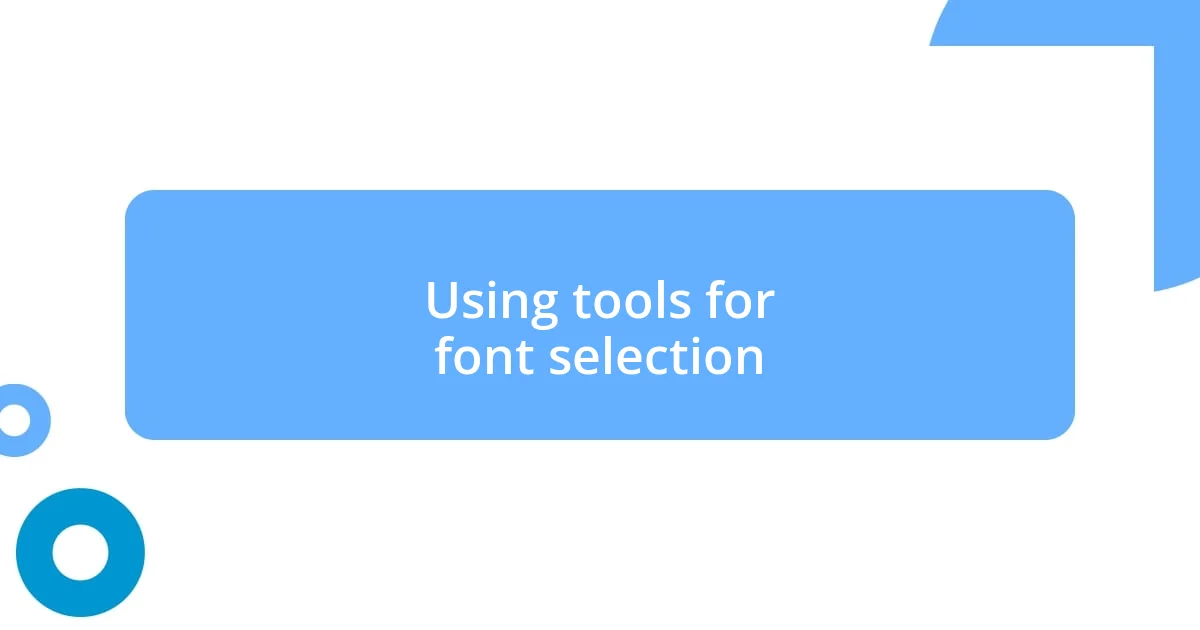
Using tools for font selection
Using online tools to select fonts has truly transformed my design process. When I stumbled upon Google Fonts, I was amazed by the vast library of typefaces I could experiment with. One afternoon, while working on a project, I used its preview feature to see how different fonts looked together in real-time. It felt like unlocking a door to endless possibilities!
I’ve also found sites like FontPair incredibly helpful for quickly spotting complementary fonts. One day, I devoted a few hours to exploring different combinations, and I loved how it streamlined my decisions. Seeing my potential choices side by side truly helped me grasp how subtle variations in style can influence a project’s overall feel. Can you imagine having that kind of clarity at your fingertips?
Additionally, I often turn to tools that allow for font pairing tests, like Canva. I recall creating a visual mockup for a nonprofit campaign, and using those pairing suggestions sparked some creative ideas I hadn’t considered before. Those interactive tools truly cater to the visual learner in me, making font selection an enjoyable rather than daunting task. Plus, who doesn’t appreciate a bit of inspiration when it comes to design?
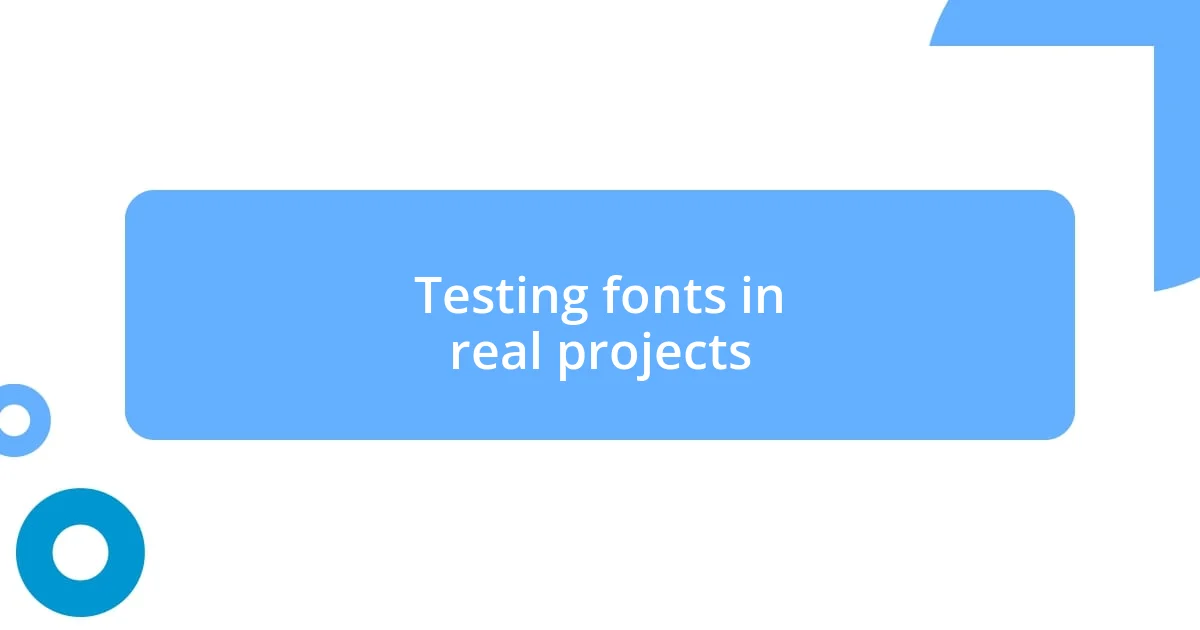
Testing fonts in real projects
Testing fonts in real projects is where the magic truly happens for me. I remember a particular website redesign I was working on for a local coffee shop. I decided to experiment with two completely different fonts—one elegant serif for headings and a playful sans-serif for body text. After running tests with actual users, their feedback was enlightening. They felt the warm, inviting vibe I aimed for, yet I hadn’t expected them to resonate so much with the playfulness; it made my heart swell.
In another instance, I was tasked with designing promotional materials for a charity event. I tested a bold, thick font against a lighter, more whimsical option. Seeing the reactions in a focus group was eye-opening—the bold choice immediately caught their attention, while the lighter option made them feel at ease. This experience taught me that context matters immensely. The setting in which a font is viewed can profoundly impact how it’s perceived. Have you ever thought about how a font can change your emotions?
Finally, I often find that a font’s readability plays a crucial role in the testing phase. During a project for an educational app, I initially selected a stylish script font that I adored. However, after testing it with a group of users, I realized it hindered their ability to absorb information quickly. I pivoted to a clean, sans-serif option, and the difference was night and day. It’s a humbling reminder that our design choices must always prioritize the user experience above all.
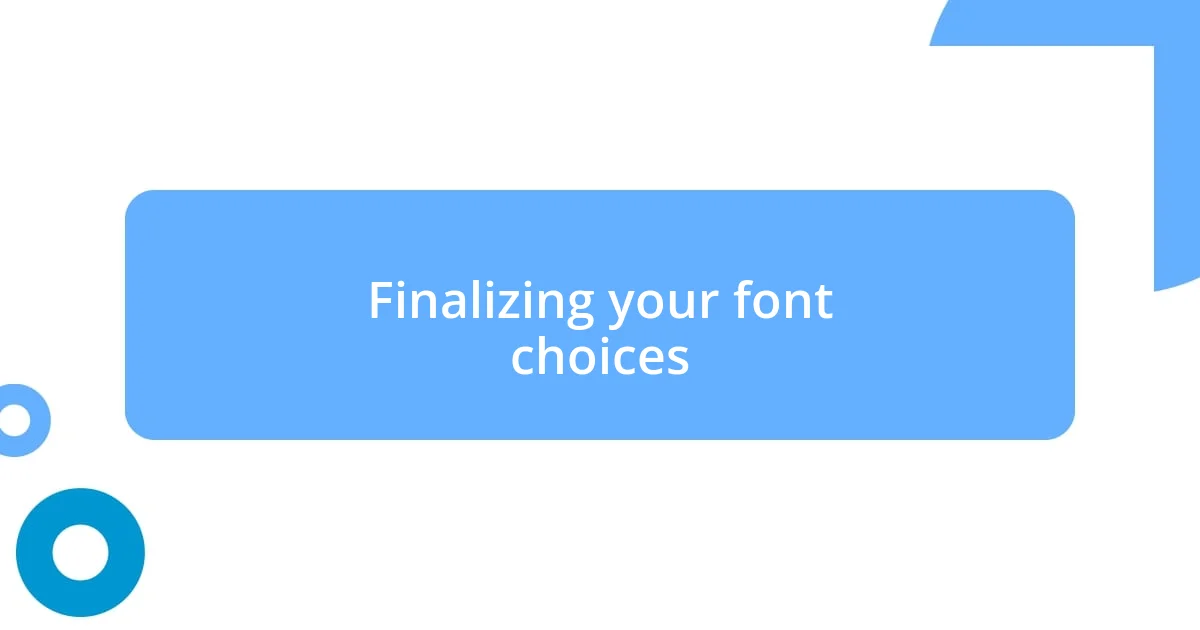
Finalizing your font choices
When finalizing your font choices, I believe taking a step back to really evaluate the emotional tone of your project is essential. I recall a branding project for a startup where I had to decide between a bold, modern font or a more traditional typeface. After much deliberation, I realized that the sleek, contemporary vibe captured the innovative spirit of the brand much better. It was a lightbulb moment that reinforced the importance of alignment between font choice and project goals.
Another aspect I focus on during this finalization phase is consistency across different mediums. One time, while designing a social media campaign, I chose a beautiful serif for the posts but neglected to consider how it would translate to smaller screens. After receiving feedback from my peers, I understood that legibility is crucial—especially when reaching a diverse audience. Have you ever found yourself bombarded with different font sizes on social media? It made me rethink how a font’s character should remain consistent in both digital and print formats.
Additionally, I often conduct one last round of feedback on my font choices before I seal the deal. There was a memorable instance when finalizing the typography for a wedding invitation design. I gathered a few friends and presented my top options. The excitement in their eyes as they weighed in on their favorites provided a warmth that helped confirm my direction. What’s your personal process for getting that final “yes” on your font choices? I’ve learned that taking the time to gather insights from others can add that final layer of confidence in your selections.




